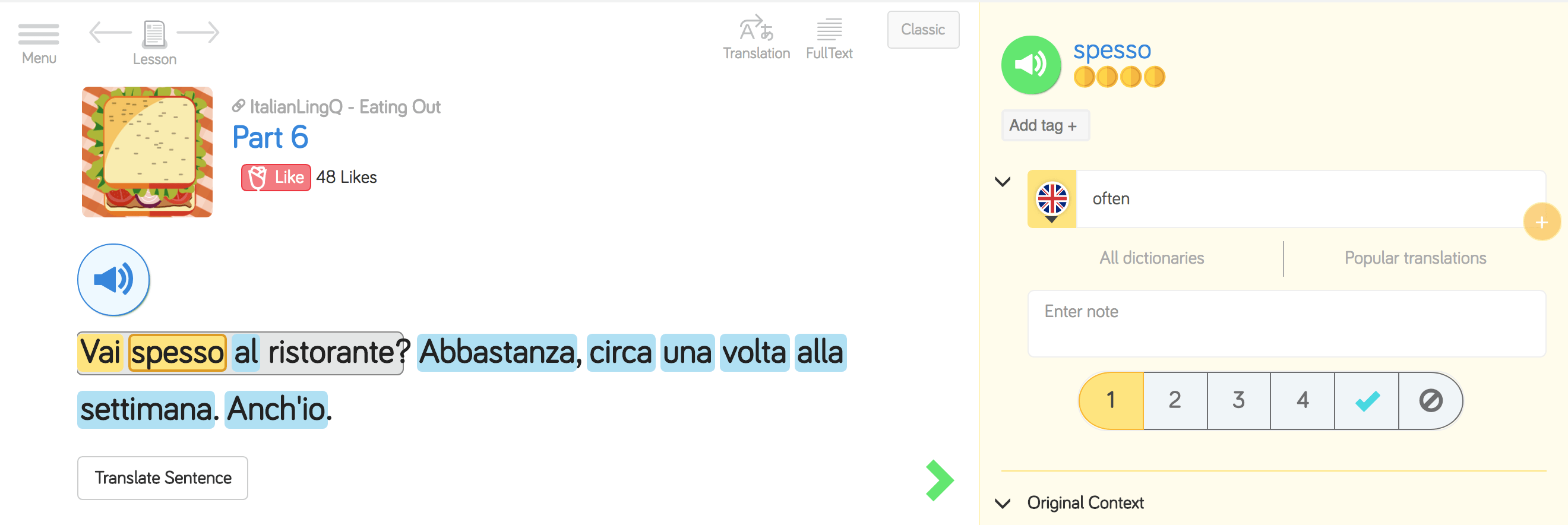Italian Conjugation Made Simple
Italian conjugation may give you a real headache! Especially if you look at all the forms and tenses you don’t know as a beginner. It’s enough to make you feel entirely overwhelmed.
Calm down and do not panic. It really is possible to learn all these forms and incorporate them into both speech and writing. Just please remember to learn step by step and only take on a new grammar unit once you are comfortable with the previous one.

Slow and steady wins the race
First of all, you should get used to learning in a systematic way.
Do you remember when you were in primary school? You studied only the last day before the history exam and you still managed to ace the test? That was cool, right? Unfortunately, this approach does not work with language learning.
The problem with last minute learning is that, as a result, you remember things only for a short period of time. As a language learner you are aiming at keeping your grammar knowledge long-term as it is the foundation of your general language skills. This is why the only way to truly improve your knowledge of Italian conjugation is to study the verbs and the way in which they conjugate as often as you can.
It is not enough to just sit down and memorize the various forms in one evening. You may want to use this approach to jumpstart the learning process, but afterwards you have to keep repeating what you have learnt over and over again.

Italian conjugation: regular verbs
There are a lot of various conjugation forms in Italian as it has both regular and irregular verbs. With the latter your only choice is to learn the forms by heart. In the case of regular verbs, however, there are patterns to follow, which apply to a whole group of verbs (yay!). The verbs are grouped, depending on their ending:
–are
amare – to love
–ere
credere – to believe
–ire
aprire – to open

Regular verbs ending in -are
To conjugate verbs in Italian we need the infinitive form, for instance, “parlare”. Then we separate the stem from the ending and add new endings required by a tense. In the verb “parlare” the stem is “parl” and the ending is “are”. Let us assume that you are learning the conjugation of the “–are” verbs in the present tense (presente). After we have chopped off the “-are” part, we conjugate in the following way:
parlare – to speak, to talk
Singular
Io parlo – I speak
Tu parli – you speak
Lui, lei parla – he, she speaks
Plural
Noi parliamo – we speak
Voi parlate – you speak
Loro parlano – they speak
As the conjugated form implies a person, we do not often use personal pronouns in Italian. If you say “parlo” I know that you are referring to yourself, while if you say “parliamo” it is clear that you are saying “we speak”. Most regular verbs ending with “-are” will follow the conjugation pattern explained above.

Regular verbs ending in -ere
Now let us have a look at the second conjugation group, namely the “–ere” verbs.
Perdere – to lose
Singular
Io perdo – I lose
Tu perdi – you lose
Lui, lei perde – he, she loses
Plural
Noi perdiamo – we lose
Voi perdete – you lose
Loro perdono – they lose
Have you noticed something? There are very tiny differences between the first group of verbs finishing with –are and the second finishing with -ere. Out of six persons, four have the same endings for both conjugation patterns!
The alternation happens only in the third person singular (lui, lei) and in the second person plural (voi) with a difference between “a” for the –are verbs (parla, parlate) and “e” in –ere verbs (perde, perdete).
Regular verbs ending in -ire
You will not be surprised by the fact that many verbs ending with “ire” will also conjugate in a similar way:
Dormire – to sleep
Singular
Io dormo – I sleep
Tu dormi – you sleep
Lei, lui dorme – he, she sleeps
Plural
Noi dormiamo – we sleep
Voi dormite – you sleep
Loro dormono – they sleep

As with the two previous types of verbs, the endings for io, tu, noi and loro are the same. The difference in the –ire verbs appears only in the third person singular with a slightly surprising “e” (dorme) just like in –ere verbs and the second person plural with the predictable “i” (dormite).
Learning all these forms does not seem that challenging now that you can see the pattern, does it? By learning just one conjugation pattern for the regular verbs, you can successfully predict most forms in the other two groups. That’s not too bad but… some regular verbs ending in “-ire” follow a different conjugation pattern. A good example of such a verb is “preferire”, which means “to prefer”.
Singular
Io preferisco – I prefer
Tu preferisci – you prefer
Lui, lei preferisce – he, she prefers
Plural
Noi preferiamo – we prefer
Voi preferite – you prefer
Loro preferiscono – they prefer
Do not ask me why there are two different conjugation patterns for the same group of verbs. There is also no magical way of knowing which verb will follow which pattern other than learning the forms and listening to a lot of Italian.
I can assure you that at some point things start to sound right or wrong to you. Before that happens, you can try to remember the form for the first person singular, in other words, the “io” (“I”) form of the verbs ending with -ire. It will serve as an indication of the conjugation pattern to use as when you remember that it is “io sento” (“I feel”), you know that it follows the first discussed conjugation pattern and therefore you know that the second form will be “tu senti” (“you feel”), etc.
Consequently, remembering that we say “io finisco” (“I finish”) will give you a hint that this verb follows the second group of conjugation for the -ire verbs and you will know that the next form is “tu finisci” (“you finish”).
Final tips on learning Italian conjugation
The most important thing when encountering a new tense is to first learn the conjugation for regular verbs for all three groups we have discussed today. This way you will soon start to develop a linguistic intuition and then learning will become much easier.

I know it seems like a tedious task. However, there are many additional ways to learn Italian conjugation, not just sitting down and repeating the verbs in an appropriate tense or mode out loud (I am afraid that some of this has to be done too, though). You can, for instance, have mini dialogues with yourself and if this makes you feel a little bit crazy, you can write down simple sentences in English and translate them into Italian.
Repeated exposure to the conjugations in interesting content is a fantastic way to memorize them without it feeling like a drag, and LingQ is the perfect system for doing it. You can even tag the conjugations so you can see them all in a list.

Good luck!
***
Magdalena Osiejewicz-Cooper has lived in Bologna and Palermo. Apart from Italian she speaks fluent Polish and French. She is currently self-studying Spanish.

